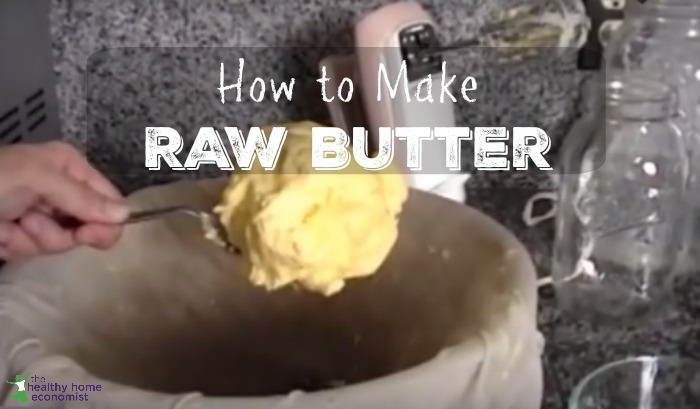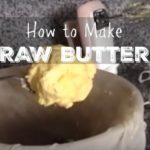Simple and easy recipe with video tutorial on how to make butter from raw or pasteurized cream to enjoy the ancestral health benefits of this nutrient-dense traditional food.

Ah, homemade butter. Has there ever been a more perfect food?
To the Traditional Swiss living in the isolated Loetschental valley early in the last century, raw butter made from unpasteurized cream was a sacred food. No pale supermarket butter, but a golden alpine butter made from the rich, beige raw cream of cows grazing on thick grass.
The children raised on this nutrient-dense, raw butter had strong physiques, and wide faces with plenty of room for their teeth. They also had high resistance to disease. There wasn’t a single case of TB in the Loetschental Valley despite this illness raging elsewhere in Switzerland during the early part of the 1900s. At that time, the Swiss villagers still existed on foods grown or sourced themselves in the valley. Only salt was brought in from the outside.
The young men raised on this nutrient-dense traditional diet with plenty of raw, deep yellow butter were so perfect and pleasing in physique, strength, and character that the Vatican favored them over all others in Europe to serve as the Papal Guard.
The Loetschental Swiss knew that it was this nutrient-dense, raw butter that was responsible for their robust health. The indigenous Swiss would put wicks in bowls of the first spring butter and burn it in their Churches!
We now know that this sacred food contained ample amounts of true Vitamin A, D, and K2. When sufficient amounts of these fat-soluble vitamins are present in the diet, they work synergistically to produce a level of health unknown in modern civilization.
The Importance of Raw Butter in the Diet
When I first became knowledgeable on the subject of Traditional Diets, obtaining plenty of raw, grass-fed butter for my family became a primary goal.
The problem was that raw butter was not available anywhere near where I lived. I couldn’t even find raw cream or unpasteurized milk for that matter!
Determined to have this sacred food for my husband and me (I was pregnant at the time) and for my oldest child who was a young toddler, I sourced quarts of frozen, raw grass-fed cream from elsewhere and shipped in 9 or more quarts a month for my family’s use.
With some of that beautiful beige, grass-fed cream, I would make the most tantalizing, golden butter for my family. I continued this habit for many years.
I am fortunate that now I am able to obtain raw, grass-fed butter locally so I rarely have to make my own raw butter anymore. However, I thought it would be helpful to show you how to make this sacred food for yourself in case some of you are in the same predicament that I was many years ago – desperately wanting raw, grass-fed butter but unable to find any!
How to Source Grassfed Cream
The only thing you really need when making butter is quality pastured cream. Don’t use anything else or your butter will turn out white or at best pale yellow. A light-colored butter indicates a low amount of fat-soluble vitamins.
The easiest route is to buy quarts of raw, grass-fed cream from a local farm. If you don’t have a local grass-based dairy farm nearby, you can request your local health food store to stock a pasteurized cream.
Natural by Nature is a good brand as is this pastured A2 cream.
This brand of Devon cream is excellent too and can be mail-ordered to your door.
Be sure to avoid UHT pasteurized cream by Organic Valley as it is too overly processed.
If you can obtain raw, pastured milk but not cream, you could also take the cream off the top of a gallon or two of the milk using a turkey baster and make butter with that cream.
The key is to get creative!
Don’t take no for an answer if you can’t find quality cream where you live. Figure out where to get it whether it be sucked off the top of a few gallons of grass-fed milk or shipped in from another place. A great way to find farms that will mail order cream to you can be found in the Weston A. Price Foundation Shopping Guide.
Can’t Tolerate Butter?
If due to allergy or availability, you are unable to enjoy the benefits of pastured raw butter on a regular basis, it is very important to be sure you’re getting sufficient Vitamin K2 (called the “X-Factor” by Dr. Price) in the diet via a whole food derived K2 supplement (as MK-7, the fermented form). Another dairy-free option to obtain K2 (as MK-4, the animal form) is Australian emu oil.
Both forms of Vitamin K2 synergize with Vitamin A and D obtained in the diet and/or via high vitamin cod liver oil for maximum absorption and effectiveness. The three together are particularly effective at maintaining the health of the teeth and gums.
Homemade Butter
The recipe below details the instructions demonstrated in the video tutorial. You may use either raw or pasteurized cream, preferably from pastured animals.
Note that once you make the butter, you can easily take it one more step to make homemade ghee, which is shelf-stable. Both ghee and raw butter oil are concentrated forms of all the goodness of butter!

How to Make Butter
Recipe for homemade butter using pasteurized or raw cream. Super easy and when sourced from pastured cows, is one of the healthiest foods on the planet.
Ingredients
- 1 quart cream preferably raw and grassfed
- 1 large glass bowl
- 1 hand mixer
Instructions
-
Pour cream into the bowl and let come to room temperature.
-
Turn on hand mixer on medium speed and mix until the cream turns into butter. You will know this because suddenly, the butter will separate from the buttermilk in the bowl and change color to yellow. This takes about 3 minutes.
-
Add 2 cups ice cold water and remix for a few seconds. Pour butter mixture into a fine mesh cheesecloth, gather up the ends and squeeze bag to strain out the water mixed with buttermilk. Repeat this rinsing process one or two more times as desired to make sure all the buttermilk is removed for the sweetest tasting butter.
-
Scoop the butter into a small container with a lid. Refrigerate.
Recipe Video
Recipe Notes
If you use slightly soured cream in this recipe instead of fresh cream, you will have cultured butter!
Reference
Nutrition and Physical Degeneration, Dr. Weston A. Price








This site really has all the information I needed concerning this subject
and didn’t know who to ask.
Sue Lyndes
Anna Weskerna FYI
I have just switched to local grassfed raw milk and just made my first batch of butter and it was white! Is this normal for cream from the winter months, or do I need to switch farmers? I have made butter from local grassfed pasteurized cream (though they are supplemented grains in the winter) and it came out a nice yellow. Is there any benefit in my butter if its white?
I just made my first batchS of butter. I purchased a 5 lb tub of pasture fed heavy cream.
I was a deep creamy yellow and so thick I had to “scoop” it out. It whipped up very quickly into butter curds, next to zero buttermilk in the bottom of the bowel for ALL 8 batches.
When it came to cleaning up the beaters and bowel, I as blown away I did not need to
use my “degreaser” dish soap.
I rinsed the beaters and bowel with hot water first and there was ZERO greasy/oily
film left…. no need for grease cutting dish soap.
So this stuff is water soluble which is probably the reason why it’s so dang good for us along with all it’s other life giving goodies.
Hi Sarah, quick question, I made butter about a week ago and saved the buttermilk. I kept the buttermilk in the fridge and now its thick. Like really thick and smells kinda strong. Nothing horrible but strong. Is this normal? Does it usually get thicker on its own in the fridge? I thought in order for it to culture it needs to be at room temperature. Can I use this just like cultured buttermilk where a baked good needs the acid to rise? Like buttermilk biscuits. Thanks in advance!
Hey there Sarah!
I’m a small her goat owner and get my milk fresh every day. I did make the butter as your instructions indicated, but it is COMPLETELY white, not even a little yellow. Is it just a difference in cow vs goat milk (if you know).
You are my number one trusted source for what to do with all my dairy so far.
Thanks~
Chelsea
I’m confused about the yellow color. I get completely organic grass fed raw milk from a friend of mine. I skim the cream off the top and make butter, which is never yellow. Never. It’s always white. Also, it’s not necessary to add the cold water. You can eat it directly after you mix (which we do by hand, not a mixer) and it’s just as lovely.
If its white butter, those cows aren’t getting any green grass!